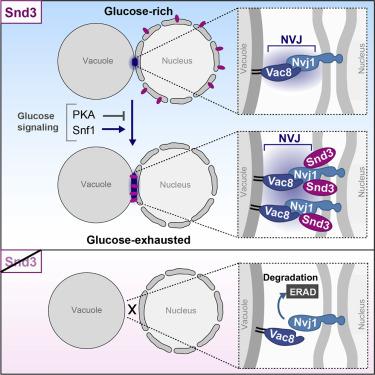Cell Reports ( IF 8.8 ) Pub Date : 2021-01-19 , DOI: 10.1016/j.celrep.2020.108637 Sergi Tosal-Castano 1 , Carlotta Peselj 1 , Verena Kohler 1 , Lukas Habernig 1 , Lisa Larsson Berglund 2 , Mahsa Ebrahimi 1 , F-Nora Vögtle 3 , Johanna Höög 2 , Claes Andréasson 1 , Sabrina Büttner 4

|
Membrane contact sites facilitate the exchange of metabolites between organelles to support interorganellar communication. The nucleus-vacuole junctions (NVJs) establish physical contact between the perinuclear endoplasmic reticulum (ER) and the vacuole. Although the NVJ tethers are known, how NVJ abundance and composition are controlled in response to metabolic cues remains elusive. Here, we identify the ER protein Snd3 as central factor for NVJ formation. Snd3 interacts with NVJ tethers, supports their targeting to the contacts, and is essential for NVJ formation. Upon glucose exhaustion, Snd3 relocalizes from the ER to NVJs and promotes contact expansion regulated by central glucose signaling pathways. Glucose replenishment induces the rapid dissociation of Snd3 from the NVJs, preceding the slow disassembly of the junctions. In sum, this study identifies a key factor required for formation and regulation of NVJs and provides a paradigm for metabolic control of membrane contact sites.
中文翻译:

Snd3 控制核-液泡连接以响应葡萄糖信号
膜接触位点促进细胞器之间代谢物的交换,以支持细胞器间的通讯。核-液泡连接 (NVJ) 在核周内质网 (ER) 和液泡之间建立物理接触。尽管 NVJ 系绳是已知的,但如何控制 NVJ 丰度和组成以响应代谢线索仍然难以捉摸。在这里,我们将 ER 蛋白 Snd3 确定为 NVJ 形成的中心因素。Snd3 与 NVJ 系绳相互作用,支持它们针对联系人,并且对于 NVJ 形成至关重要。在葡萄糖耗尽后,Snd3 从 ER 重新定位到 NVJ,并促进由中央葡萄糖信号通路调节的接触扩展。葡萄糖补充诱导 Snd3 从 NVJ 中快速解离,在连接处缓慢分解之前。总共,



























 京公网安备 11010802027423号
京公网安备 11010802027423号